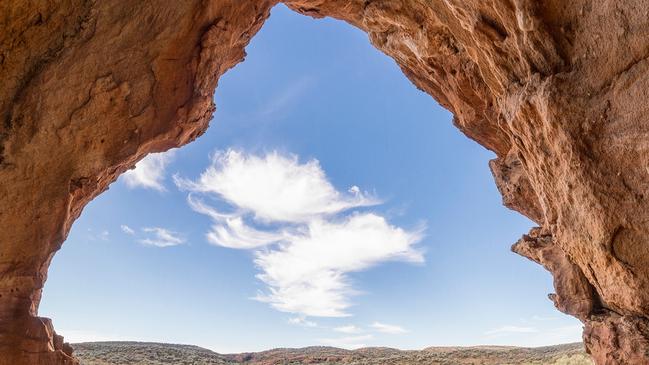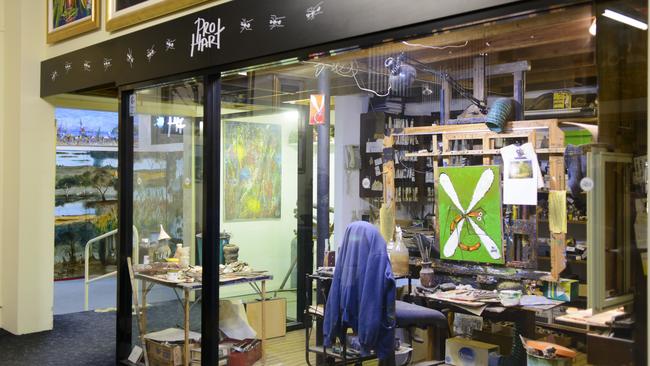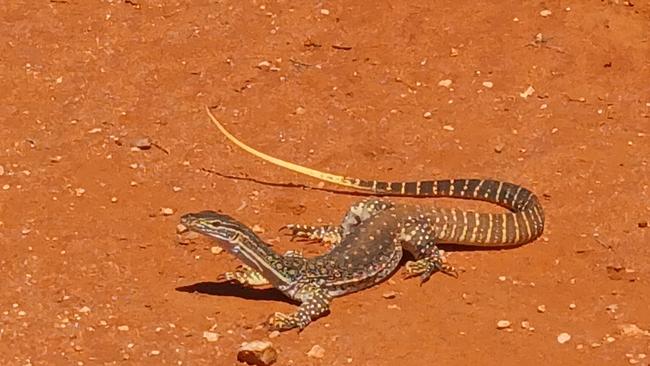Broken Hill, NSW: The world’s oldest ‘art town’
Dragons and goats are at war here, and ancient footprints still mark its red earth. Jane Nicholls explores one of Australia’s most intriguing outback regions.

It’s been more than 30 years since I’ve been this far west in my home state of NSW, yet my heart feels full from the moment I land in Broken Hill. This country is rich with stories, many held in the rocks and soil themselves, so it seems fitting the week-long outing with Renaissance Tours that lies ahead is called Ancient Landscapes and Sacred Sites. The journey kicks off with four nights in Broken Hill. Our tour group comprises three friends, a couple of couples, tour leader Alex McKay, local First Nations guide and driver Mark Sutton, one other single traveller and me. We’re one of the most simpatico coteries I’ve encountered on such trips.
We head out of town in our 4WD coach to the Living Desert State Park to see the Sunset Sculptures. In 1993, 53 tonnes of sandstone were brought in from Wilcannia, 200km to the east, and a dozen carvings were created in situ by artists from around the world. Antonio Nava Tirado’s Under the Jaguar Sun is selfie central as the sun drops, poking its rays through a perfectly positioned circle.
Our leader, Alex – academic, author and warm and knowledgeable storyteller – tells us about Ngatji, or Rainbow Serpent, carved by renowned Barkandji artist Badger Bates, whose influence is writ large on the artistic community here. Back in the 1970s, the Brushmen of the Bush – five artists, including Pro Hart and Jack Absalom – were hailed as establishing Broken Hill as an art town. We visit Hart’s former home, now a well-conceived gallery complete with preserved studio, his famous painted Rolls-Royces and, 17 years after his death, plenty of originals for sale.

The real history of art out here goes back tens of thousands of years, as we see at the spectacular Mutawintji National Park. In the space of a 2km walk, we are shown three kinds of Indigenous rock art – stencils, paintings and petroglyphs or carvings. As well as taking us around this week, Mark Sutton is senior tour guide with Mutawintji Heritage Tours, providing access to a historic area that is padlocked due to past theft and desecration. Unfortunately, some feral animals still get in. “They have a real impact on the rock art. They scrape the engravings with their hooves, rub against the painted artwork with their bodies, and they’re terrible for the native flora and fauna,” Sutton tells me as we eat our picnic lunch in the campground, surrounded by apostlebirds, galahs and shy mulga parrots. “The No. 1 comment in the visitors book is ‘What are you doing about the goats?’.”
In Australia’s arid and semi-arid regions, authorities estimate there are about 2.5 million of these feral ruminants. Sutton reckons that number should be multiplied by 10, and Mutawintji rotates through three independent contractors to trap and remove them. “You don’t want anyone to deliberately leave a breeding pair behind,” he says. “If you can trap them and get them alive to the halal meatworks up in Bourke, they’re worth $150 for a nanny and $200 for a billy.”
Mutawintji means “a place of green grass and water”, and it is indeed an oasis, with veteran river red gums and rock pools among the sandstone gorges. It’s easy to see why it’s been such a sacred place for the Wiimpatja people, with evidence of their continuous occupation for 8000 years and likely longer.

The endangered Barrier Range dragon makes its home among the red, craggy sandstone. “In the breeding season, the little males stand on the rocks displaying their beautiful throat colouration, [saying] ‘I’m strong, mate with me’,” says artist Alison Clouston. Her installation Mirrityana – out in the sunlight, with sound artist Boyd, is on show at the Broken Hill City Art Gallery until the end of July. The multimedia collection includes mulga trunks with found goat horns fused into their branches, accompanied by Boyd’s field recordings, all collected in Mutawintji and surrounds with permission from Wilyakali Baakintji traditional owners and in collaboration with threatened species researchers. The sounds are entrancing – wind in eucalypt leaves, the snap and crackle of invertebrates in waterholes, insect swarms, all of the previously mentioned birds … and the many plops of goat droppings hitting the earth or the sandstone. “Their droppings just pour into the crevasses,” says Clouston.
She wants to draw attention to the endangered lizard and the impact of the goats, but adds they were shocked at how much bush was cleared in the early days of Broken Hill’s mining boom in the late 1800s, leading to biodiversity loss, soil erosion and dust storms. The largest known zinc-lead-silver ore body on the planet is still mined almost 140 years on, and there are famously more traffic lights and trucks far underground than there are on the streets. The Line of Lode above the shafts is a monolithic sentinel in the centre of the city, topped by a sobering yet beautiful memorial to those who’ve perished mining here.

When we drive out to explore Silverton, Sutton shows us how far loggers got out to feed the need for timber for building and fuel; the flattened ring extends between 70km and 90km. Clouston points me to Trees for Travellers, which the local Landcare is setting up for visitors to “buy” a tree to be planted and help offset the carbon emissions of their trip.
For the first three nights of the tour, we stay at Broken Hill’s Royal Exchange Hotel. The old pub has been refurbished to capture its Art Deco charm, particularly in the lounge and dining room, with their soaring ceilings. The rooms are light and airy, with access to a wraparound balcony.
After four days exploring in and around Broken Hill, we travel to Menindee Lakes. I’d seen the connected giant milky blue circles of water on my flight in. Beyond that ring of clear-felling, saltbush, mulga and other trees rise up from the red dirt. And goats – so many goats, including one as big as a large calf that skips in front of our bus, deftly avoided by Sutton. He beeps to move on mobs of emus, much to our delight.
The recent floods have receded, and we’re spared witnessing the subsequent devastating fish kill, but the lakes remain full. We stop for morning tea on the thick green lawn of the Broken Hill Speedboat Club, on the shores of man-made Copi Hollow. Flocks of pelicans, great cormorants and ducks cruise past high above us and a great egret feeds elegantly in the reeds.

Our own lunch is a picnic in the shade near the vast Kinchega woolshed, built from river red gum in the region’s pastoral heyday. Much of the old machinery remains. It’s estimated six million sheep went through here over 97 years of shearing, and you can still smell the lanolin in the timber.
As we rumble our way to Mungo National Park, single herons take flight from roadside dams. Mungo is part of the Willandra Lakes World Heritage Area, where the remains of Mungo Lady and Mungo Man were found in the ’60s and ’70s and dated at least 42,000 years old. Those archaeological discoveries and subsequent ones confirmed continuous occupation by Aboriginal people and evidence of the first-known ritual burial practices, rewriting the history books.
I came here on a road trip with my now-husband 22 years ago. The sand dunes over the long-dry lake bed go from smooth and undulating to corrugated, almost sculpted, erosion constantly revealing shells and animal bones from massive middens beneath. It’s beautiful, eerie and moon-like, hence they’re called lunettes. I remember feeling I could almost see the people making their lives here around lakes full of fish, crustaceans and freshwater mussels.

Returning as an older human and a mother, a new discovery stirs my imagination. At the visitor centre there are now casts of dozens of 20,000-year-old footprints. In 2003, archaeologists found more than 500 footprints and 25 trackways pressed into the claypan, many clearly in family groups. Before they were carefully covered up to protect them, casts were made and digital scans taken to study the interactions, later interpreting stride lengths and directions and size of the footprints. Children scattering here, mothers with babes in arms treading heavily there, the giant strides of hunting groups.
We bunk down at Mungo Lodge, where cabins encircle the driveway; two rooms on each raised demountable. It’s much as I remember it from all those years ago, and I sit on the back veranda with a cool drink. Those ancient footprints are on my mind as we head out on the public boardwalk to gaze at the famed Walls of China lunette, named in the 1860s when Chinese labourers built the woolshed that still looks out on it. You can continue off the boardwalk if you take a tour with rangers from the three tribal groups – Paakantki, Mutthi Mutthi and Ngiyampaa – or other accredited guides. It’s the last night of our tour and we’re here in time for a spectacular orange sunset. Strangers are now friends, strolling and chatting amicably. We make our way through a deep gully showing distinct layers of sand and the shells of lifetimes ago and I wonder if any of our footprints could possibly remain to tell another story 20,000 years from now.
In the know
Book with Mutawintji Heritage Tours to be guided through the art sites of Mutawintji National Park, regarded as among the best in NSW. It’s 130km from Broken Hill. Half-day Kulluwirru Dreaming tours are $80.
Access to the lunettes in Mungo National Park is available only through Mungo Walk Discovery Tours with a NPWS Indigenous ranger or tours with a licensed operator.
Renaissance Tours offers a wide range of cultural tours in Australia and overseas. The domestic tour lineup for 2024 is not yet finalised, but available itineraries focusing on art, opera, ballet and music are on the company’s website. A seven-day tour of the gardens of the NSW central west is $5850 a person, twin-share.
Jane Nicholls was a guest of Renaissance Tours.




To join the conversation, please log in. Don't have an account? Register
Join the conversation, you are commenting as Logout